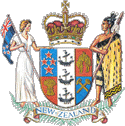Leader of the Opposition (New Zealand)
|
|
The Leader of the Opposition in New Zealand is the politician who, at least in theory, leads the Opposition bloc in the New Zealand Parliament.
Role
By convention, the Leader of the Opposition is the leader of the largest party of the Opposition.
The Leader of the Opposition does not have a large official role, as most of the post's functions are ceremonial. Nevertheless, there are several ways in which the Leader of the Opposition participates directly in affairs of state. Often, these relate to national security matters, which are supposed to transcend party politics - the New Zealand Security Intelligence Service, for example, is required to brief the Leader of the Opposition as well as the Prime Minister on certain matters.
The Leader of the Opposition also receives a higher salary than other members of the Opposition, being paid the same amount as a Cabinet Minister.
History
The office of Leader of the Opposition's in New Zealand developed gradually, and for much of the country's early history, the role was not a formal one. For most of the 19th Century, there was rarely any one person who could be considered Leader of the Opposition — those figures who took leading roles in opposing the government of the day were merely "first among equals", and had no formal office. It was only when the Liberal Party was formed that any unified leadership appeared in Parliament, and the role of Leader of the Opposition is generally traced from this point. John Ballance, leader of the Liberals (and later Premier) is usually considered the first Leader of the Opposition in the modern sense.
After Ballance led the Liberals into government, the various independents who opposed the Liberals organised themselves around a single leader, but did not establish their own party (as we would view it today). It was not until the creation of the Reform Party that a two-party system was established. From that point, the post of Leader of the Opposition alternated between the Liberal Party and the Reform Party, although the newly-founded Labour Party did manage to capture the position from 1926 to 1928. In 1935, the party dynamic changed, and the position has alternated between the Labour Party and the National Party.
After a poor showing in the 2002 elections, the National Party constituted less than half of what was (at least technically) the Opposition. As the largest party, however, its leader had still retained the title of Leader of the Opposition. This prompted a number of parties, notably New Zealand First and the Greens, to call for the abolition or reform of the post. It was argued by these parties that the position had become an "anachronism" in the modern multi-party environment, and that the days of a united opposition bloc were gone.
The current Leader of the Opposition is Don Brash.
Past Leaders of the Opposition
A table of past Leaders of the Opposition is below. The table begins in 1891, when the first real political party (the Liberals) was founded. Those who also served as Prime Minister, either before or after being Leader of the Opposition, are indicated.
* From 4 August 1915 to 21 August 1919, the Reform Party and the Liberal Party formed a joint wartime coalition. However, Joseph Ward of the Liberals officially remained "Leader of the Opposition", even though he was actually part of the government.

